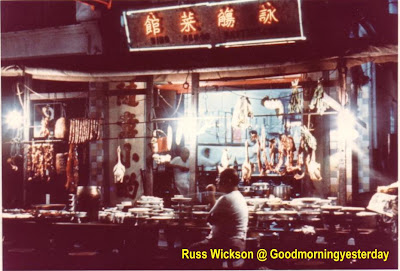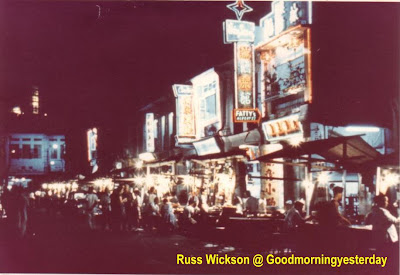Before television transmission was introduced into Singapore in 1963, I listened to stories from mother and grandmother over dinner. If that was not enough, I did my fair share of Yam Sengs at Wing Choon Yuen Restaurant because of uncles’ weddings and grandparents’ birthday functions. By the time I was in primary school, I saw my first English movies at the Sky and Globe. I think it was Werewolf! Even at the tender age of 6 months, I did my first nude pose and it was also in Great World. Don’t believe? Check this out! I am curious why a male and not a female firstborn have to do this.  Photo 2: Great World’s Lye Ying Photo Studio has a well-known embossed watermark.
Photo 2: Great World’s Lye Ying Photo Studio has a well-known embossed watermark.
Dolly my vivacious cousin remembers, “It was the era of “Worlds” then: Happy World, Gay World, Beauty World, New World and of course my Great World. I used to boast that Great World was my turf and was I proud about it. Mum would bring me there in the evenings and then I disappeared the rest of the evening running wild all over the place and returned to the shop late in the night.
 Photo 3: Give that look Dolly!
Photo 3: Give that look Dolly!
There was one night I really forgot about the time. Well, I was too young to be wearing a watch and I only knew when shops started putting up their wooden shutters - single wooden planks that you place next to each other one by one along tracks on the floor and ceiling. With crumbled dress, ribbons that untied, dishevelled hair, I reached mum’s shop which like all the other shops, was already closed for the night and there was mum standing outside the shop, her eyes “shooting fire” and in her hand was the CANE!”
Well her mum sounded like a very fierce person but to me Yee Kuchea (二姑姐) was a darling.
Yee Kuchea was a very enterprising woman and before we hear of SPRING Singapore she started her first SME (Small and Medium Enterprises) business at the Great World. She believed in the maxim, “Make what I can sell. Not sell what I can make". I remembered the shop was across Flamingo Nightclub, beside Atlantic City Cinema and the kopi char poh. On some nights I saw pretty girls dressed in frocks and cheongsams from the Flamingo with matured guys. Much later in life I learnt the guys were Kai Yeh (godfather). Whilst Dolly recalled hearing this 1961 tune from a record shop on the same row of her mum’s shop, I heard something like this from inside the Flamingo.
 Photo 4: Flamingo’s “Taxi Girls”. They can do the Cha Cha, Mambo and Rock n Roll for the price of $1. The girls were Chinese, Eurasians and sometimes Javanese girls and they stayed in shared accommodation at Bo Bo Tan Garden, Melody Mansion and Pacific Mansion (c 1960).
Photo 4: Flamingo’s “Taxi Girls”. They can do the Cha Cha, Mambo and Rock n Roll for the price of $1. The girls were Chinese, Eurasians and sometimes Javanese girls and they stayed in shared accommodation at Bo Bo Tan Garden, Melody Mansion and Pacific Mansion (c 1960).
When my parents brought me to Yee Kuchea’s shop, I was fascinated by the wide assortment of things she sold - ladies handbags, sometimes a ballerina/couple figurine dancing inside a musical box, ladies accessories/clothes, children clothes and toys. She had glass display cabinet to house her goods but some lady dresses were displayed on legless plastic-type mannequins.
Because I was curious I peeped under the mannequins and wondered why they didn’t have legs or why the dresses spread out like an open umbrella – later I learned the meaning of “Can-can”. Do you know why they call it “Can-can”? One time, I eyed a toy gun, Yee Kuchea said OK but my mum felt I Har Kuchea (Har – meaning bully or take advantage of). Many decades later I asked an elderly Yee Kuchea why she showered me with toys way even before I stepped into primary school, she replied Lay Chee Mah, Kuchea Sek Tay Lay Loong (translation: You know, your kuchea sayang you till you toasted/burnt). I am indeed deeply honoured and should be very thankful of having such a kind-hearted auntie.
 Photo 5: Yee Kuchea’s first shop Hoi Cheong (c 1950).
Photo 5: Yee Kuchea’s first shop Hoi Cheong (c 1950).
** Last Instalment: Great World: From the Director’s Chair.
** Note: Italic words have to be pronounced the Cantonese way.












 Photo 1: Some of the faithfuls who made it to the gala premier
Photo 1: Some of the faithfuls who made it to the gala premier Photo 2: My friend Salleh who has four decades of professional movie camera experience since the days of Cathay-Keris Studio explained that nowadays with digital cameras, “Rolls” have been replaced by memory cards. You see “Cards” instead.
Photo 2: My friend Salleh who has four decades of professional movie camera experience since the days of Cathay-Keris Studio explained that nowadays with digital cameras, “Rolls” have been replaced by memory cards. You see “Cards” instead. Photo 3: Me a cinema addict? Some cinema tickets from Globe Cinema, Great World (c 1959, 1960, 1961).
Photo 3: Me a cinema addict? Some cinema tickets from Globe Cinema, Great World (c 1959, 1960, 1961). Photo 4: Left to Right - Some of the cast members take a break. Do you remember that lady in red polka-dot frock? Prop crew fixing the red banner to welcome Elizabeth Taylor; Camera Director is seated on the tulip which can swing and elevate in different directions.
Photo 4: Left to Right - Some of the cast members take a break. Do you remember that lady in red polka-dot frock? Prop crew fixing the red banner to welcome Elizabeth Taylor; Camera Director is seated on the tulip which can swing and elevate in different directions. Photo 1: Cut! Cut! Cut!
Photo 1: Cut! Cut! Cut! Photo 2: Great World’s Lye Ying Photo
Photo 2: Great World’s Lye Ying Photo  Photo 3: Give that look Dolly!
Photo 3: Give that look Dolly! Photo 4: Flamingo’s “Taxi Girls”. They can do the Cha Cha, Mambo and Rock n Roll for the price of $1. The girls were Chinese, Eurasians and sometimes Javanese girls and they stayed in shared accommodation at Bo Bo Tan Garden, Melody Mansion and Pacific Mansion (c 1960).
Photo 4: Flamingo’s “Taxi Girls”. They can do the Cha Cha, Mambo and Rock n Roll for the price of $1. The girls were Chinese, Eurasians and sometimes Javanese girls and they stayed in shared accommodation at Bo Bo Tan Garden, Melody Mansion and Pacific Mansion (c 1960). Photo 5: Yee Kuchea’s first shop Hoi Cheong (c 1950).
Photo 5: Yee Kuchea’s first shop Hoi Cheong (c 1950).


